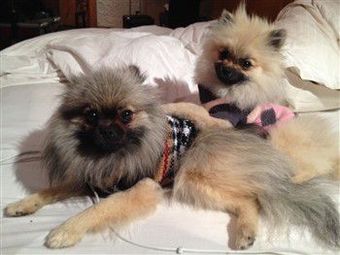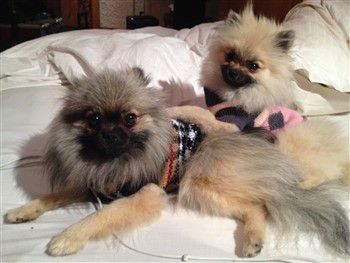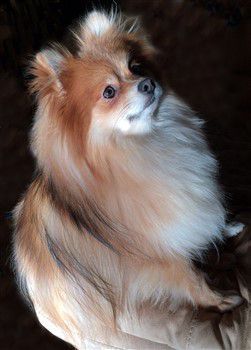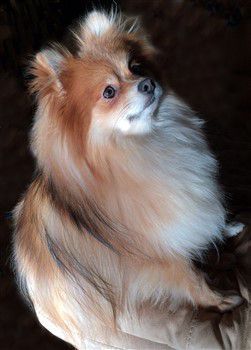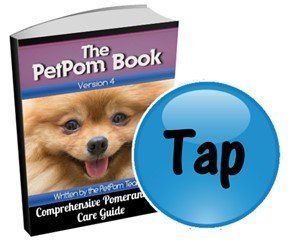Sable Pomeranians
Overview
The element of sable can be confusing to many Pom lovers as they wonder exactly what it is. While it is listed among colors, there is much more to it.
Sable refers to dark tipped hairs. These darker hairs, the sable, can appear on just about any base color. In addition, while many sable Pomeranians will have black as their sable, some will have a dark orange, dark chocolate or other sabling.
The important element to keep in mind, is that those hairs cannot be of a lighter color; to be sable, they are darker than the rest of the coat.
As you can see from the photo here (right; below on mobile), sabling is indeed 'tipped hairs'. It creates a layer of color over the base.
Luna and Wolfi, (cream sable, wolf sable). Both have black muzzles (very rare).
Photo courtesy of Will and Cristina Johnston
In places where it is very heavy, such as the ruff around the neck, you do not see the cream underneath. And in places were the sable is lighter, such as the flanks, you can see under it to the coat beneath.
Sable Can Appear in Distinct Areas
Sabling can be heavy, moderate or light. It can appear on the majority of the coat, or it can appear in just a few places.
Just about every sable Pomeranian will have that sabling on his back, also referred to as the saddle. That is a given.
This said, it may or may not appear in other places as well.
When it does appear on other parts of the coat, the sable may be on the head, legs, chest, ruff and/or tail.
It would be exceptionally rare for a Pom to have sable on other areas but not appear on the dog's back; for example being seen on the chest and tail, but not over the saddle.
With this Pom (right, below on mobile), long sable pieces come down over the Pom's back, which are very distinguishable over her light orange and cream, which is a parti coat (two color).
We believe that as a young pup, she most likely had much more sable, but as she grew that sable came out, leaving just these nice long pieces that pleasantly frame her and complements her beautiful dark eyes.
Nanuk, an orange and cream (parti) sable
Photo courtesy of Valerie Orlando
If you were to
shave a Pomeranian such as this (never recommended and just speaking hypothetically) you can imagine that the sable would be trimmed off and the Pom would appear to just be an orange and cream. Though, genetically, the Pom would still be a sable.
Changes with Sables
There are not any Pomeranians that have zero changes in color
as they mature; it is just a matter to what degree this happens.
During the first year, a Pom puppy will experience a drastic transformation; this is referred to as the puppy uglies. During this time the downy soft puppy coat (that does not have guard hairs), falls out and is replaced with the permanent adult coat, which consists of 2 layers, inner dense undercoat and longer, guard haired outer coat. Base color often changes at this time, either getting a bit lighter or darker.
Now, with sable
Pomeranians, the main element to keep in mind is that the sable will not remain the same. In most cases, it will decrease; many Poms outgrow their sable.
So, while the Pom will be registered as a sable and he may have had quite a bit when young, it will fade out and for some, barely be visible in the adult coat. With that said, in rare cases, just the opposite will happen, which can be a happy surprise.
In these photos below, you'll see Bentley, a cream sable Pomeranian at 12 weeks old (photo 1). His sable is there, most notably on his head up over the ears and a bit on his back. One would expect him to grow right out of that.
However, in looking at photo 2, he is seen as an adult and his sable is much stronger. You can see that not only did it remain on his ears, it darkened as well. And look at his back; what was once a few dark tipped hairs is now seen very well as it has come in thicker and is a darker color as well.
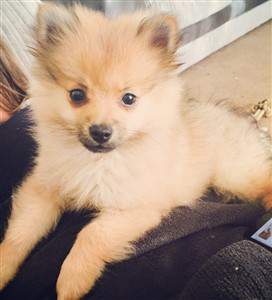
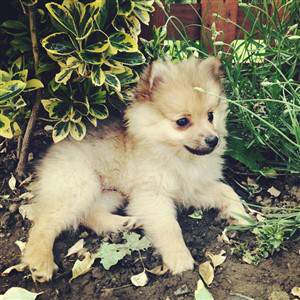
Bentley, at 12 weeks old and then as an adult; Photo courtesy of Lyssa
Sable Genetics
Sable (A^y) is a dominant gene. This means that when you pair two Pomeranains, only one of them needs to carry this gene for the resulting litter to have sable. Therefore, if you pair a sable Pom with a non-sable, will produce sables.
Sable Vs Wolf Sable
Sable Vs Wolf Sable
Many sable Poms with a gray coat will be labeled as
wolf sable; however, in most cases that classification will be incorrect. Wolf sable is exceptionally rare, caused by the (aw) gene. Only with DNA testing can you be certain that a Pom that appears wolf sable is indeed just that.
Examples of Sable Pomeranians
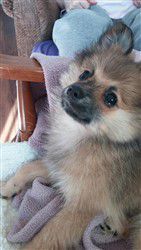
Orange sable
- heavy - If sabling is heavy, it will cover the orange in this way, almost creating a blanket of sorts over the base color.
Tiny (6 months old, 6 lbs.)
Photo courtesy of GrammaPink
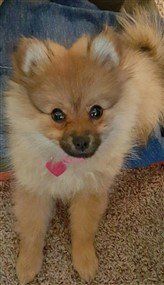
Orange sable- light -At first glance you may think that this Pom is an orange and cream; however, if you look closely you will see that there is some light sabling starting at the eyes and going over the head. Even just a little bit does indeed count and therefore this is an orange and cream sable.
Ms. Beasley
Photo courtesy of Jo Beth Latimer

Sable Pomeranian shaved, before and after
- While we do not recommend ever trimming this close (the coat may never grow back again the same), it is interesting to see how the sable looks once shaved.
Fluffy
Photo courtesy of Gail Massie
You May Also Like:
How to Control a Pomeranian's Barking
- Poms will be vocal to some extent; however, you should intervene if barking becomes excessive.


